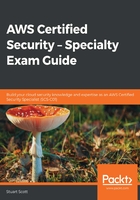
To get the most out of this book
Throughout this book, there are a number of demonstrations that you can follow to help with your learning. As a result, I suggest you have your own AWS account created that is not used for any production environments. You can follow along on either a Linux-based or windows-based operating system, however, I suggest you also have the AWS CLI installed.

To create a new AWS account, please follow the guide found at: https://aws.amazon.com/premiumsupport/knowledge-center/create-and-activate-aws-account/.
To install the AWS CLI, please follow the guide found at: https://docs.aws.amazon.com/cli/latest/userguide/cli-chap-install.html.
On completion of this book, I suggest you get as much hands-on experience with AWS as possible to use the different AWS services that are discussed to help reinforce the material from each of the chapters.
Code in Action
Code in Action videos for this book can be viewed at (https://bit.ly/33jnvMT).
Download the color images
We also provide a PDF file that has color images of the screenshots/diagrams used in this book. You can download it here: http://www.packtpub.com/sites/default/files/downloads/9781789534474_ColorImages.pdf.
Conventions used
There are a number of text conventions used throughout this book.
CodeInText: Indicates code words in text, database table names, folder names, filenames, file extensions, pathnames, dummy URLs, user input, and Twitter handles. Here is an example: "The Principal parameter is used within resource-based policies to identify the user, role, account, or federated user."
A block of code is set as follows:
{
"Version": "2012-10-17",
"Statement": {
"Effect": "Allow",
"Principal": {"AWS": "arn:aws:iam::356903128354:user/Stuart"},
"Action": "sts:AssumeRole",
"Condition": {"Bool": {"aws:MultiFactorAuthPresent": "true"}}
}
}
When we wish to draw your attention to a particular part of a code block, the relevant lines or items are set in bold:
[default]
exten => s,1,Dial(Zap/1|30)
exten => s,2,Voicemail(u100)
exten => s,102,Voicemail(b100)
exten => i,1,Voicemail(s0)
Any command-line input or output is written as follows:
$ mkdir css
$ cd css
Bold: Indicates a new term, an important word, or words that you see onscreen. For example, words in menus or dialog boxes appear in the text like this. Here is an example: "Select Route Tables from the menu on the left and click the blue Create Route Table button."